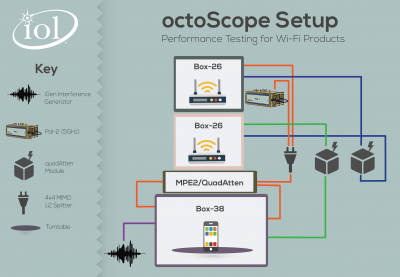[ITEM]
 [/ITEM]
[/ITEM]
27.10.2018
46


Today, the big players are expected to get into the market around August when the Wi-Fi Alliance launches its HaLow certification program. The trade group will lead up to that milestone with a series of plugfests starting this month (January). The case for 802.11ah in a crowded LPWA space.
The Wi-Fi Alliance, dedicated to developing new wireless networking standards, is planning to with the upcoming launch of the newest Wi-Fi standard, 802.11ax. 802.11ax as 'Wi-Fi 6,' making it easier for Wi-Fi users to understand the difference between 802.11ax, 802.11ac, and 802.11n. With the launch of Wi-Fi 6, 802.11ac will be known as 'Wi-Fi 5,' while 802.11n will be known as 'Wi-Fi 4.' 'For nearly two decades, Wi-Fi users have had to sort through technical naming conventions to determine if their devices support the latest Wi-Fi,' said Edgar Figueroa, president and CEO of Wi-Fi Alliance.
'Wi-Fi Alliance is excited to introduce Wi-Fi 6, and present a new naming scheme to help industry and Wi-Fi users easily understand the Wi-Fi generation supported by their device or connection.' Wi-Fi 6 will introduce higher data rates, increased capacity, better performance in dense environments like concerts and sporting events, and improved power efficiency so Wi-Fi won't eat up as much battery on future devices. In, speeds of up to 4.8Gbit/s over the 5GHz band have been reached. In demonstrations at CES, speeds maxed out at 11Gbit/s. The new capabilities being introduced are outlined below, as specified by the Wi-Fi Alliance.
This is 'meh'. All it does is create the false illusion that the higher number is better. It's not, in all cases. On a very basic level, a higher number is better, but for example, people would absolutely prefer WiFi4 over WiFi5 in a large house, as the 802.11ac signal strength is weak. If we are to believe that all future versions of WiFi - for example, WiFi7 - would both increase in signal strength, power, distance, speed, etc - then I'm all for this, otherwise it's the same problem we have now with a different name.
With the way the 802.11 protocol has worked so far, this hasn't proven true, there are often revisions that focus more on speed or power, but rarely both. Anda perdana in medio raro.
- Author: admin
- Category: Category
Search
Most Viewed Pages
- Soal Dan Jawaban Untuk Tes Excel Bagian Stock Officer
- Rafale Flight Manual Supplements
- Download Drama Korea Sweet Sex And Love Sub Indo
- Gta San Andreas Pc Tasikgame
- Digimon 123sub Indo
- Free Download Ultimate Drive Increaser,increase Drive Size
- Aerosoft Airbus X Extended Torrent
- Alexander Mccall Smith Torrent Ebook Fr
- Cara Mengubah File Exe Menjadi Pdf
- Morgan Mjpeg Codec V3 Serialy
- Cara Menggunakan Keygen Corel Video Studio X6 Tutorial Points
- Spiderman 3 The Battle Within Game Online
- Free Download Sheila On 7 Lupakanlah Diriku
- Irisskin Full Crack Cinema

Today, the big players are expected to get into the market around August when the Wi-Fi Alliance launches its HaLow certification program. The trade group will lead up to that milestone with a series of plugfests starting this month (January). The case for 802.11ah in a crowded LPWA space.
The Wi-Fi Alliance, dedicated to developing new wireless networking standards, is planning to with the upcoming launch of the newest Wi-Fi standard, 802.11ax. 802.11ax as 'Wi-Fi 6,' making it easier for Wi-Fi users to understand the difference between 802.11ax, 802.11ac, and 802.11n. With the launch of Wi-Fi 6, 802.11ac will be known as 'Wi-Fi 5,' while 802.11n will be known as 'Wi-Fi 4.' 'For nearly two decades, Wi-Fi users have had to sort through technical naming conventions to determine if their devices support the latest Wi-Fi,' said Edgar Figueroa, president and CEO of Wi-Fi Alliance.
'Wi-Fi Alliance is excited to introduce Wi-Fi 6, and present a new naming scheme to help industry and Wi-Fi users easily understand the Wi-Fi generation supported by their device or connection.' Wi-Fi 6 will introduce higher data rates, increased capacity, better performance in dense environments like concerts and sporting events, and improved power efficiency so Wi-Fi won't eat up as much battery on future devices. In, speeds of up to 4.8Gbit/s over the 5GHz band have been reached. In demonstrations at CES, speeds maxed out at 11Gbit/s. The new capabilities being introduced are outlined below, as specified by the Wi-Fi Alliance.
This is 'meh'. All it does is create the false illusion that the higher number is better. It's not, in all cases. On a very basic level, a higher number is better, but for example, people would absolutely prefer WiFi4 over WiFi5 in a large house, as the 802.11ac signal strength is weak. If we are to believe that all future versions of WiFi - for example, WiFi7 - would both increase in signal strength, power, distance, speed, etc - then I'm all for this, otherwise it's the same problem we have now with a different name.
With the way the 802.11 protocol has worked so far, this hasn't proven true, there are often revisions that focus more on speed or power, but rarely both. Anda perdana in medio raro.
Search
Most Viewed Pages
- Soal Dan Jawaban Untuk Tes Excel Bagian Stock Officer
- Rafale Flight Manual Supplements
- Download Drama Korea Sweet Sex And Love Sub Indo
- Gta San Andreas Pc Tasikgame
- Digimon 123sub Indo
- Free Download Ultimate Drive Increaser,increase Drive Size
- Aerosoft Airbus X Extended Torrent
- Alexander Mccall Smith Torrent Ebook Fr
- Cara Mengubah File Exe Menjadi Pdf
- Morgan Mjpeg Codec V3 Serialy
- Cara Menggunakan Keygen Corel Video Studio X6 Tutorial Points
- Spiderman 3 The Battle Within Game Online
- Free Download Sheila On 7 Lupakanlah Diriku
- Irisskin Full Crack Cinema
Wi Fi Alliance Plugfests В© 2019